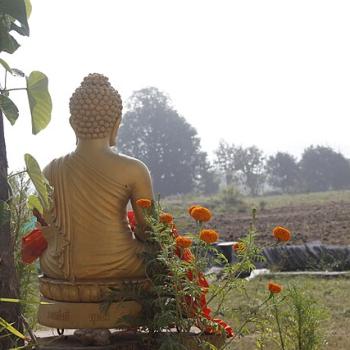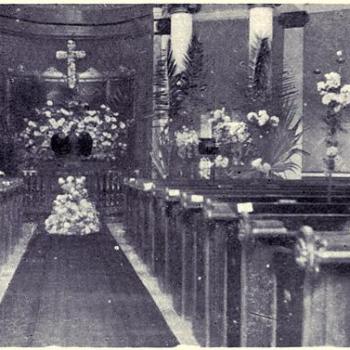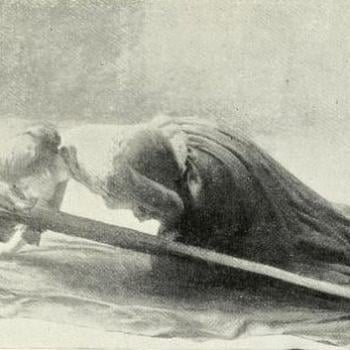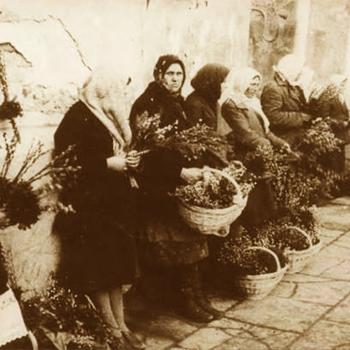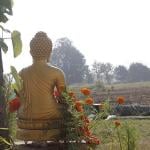LIFE’S PILGRIMAGE
A Meditation on a Once and Future Spiritual Discipline
29 September 2013
James Ishmael Ford
Senior Minister
First Unitarian Church
Providence, Rhode Island
Text
What is rooted is easy to nourish.
What is recent is easy to correct.
What is brittle is easy to break.
What is small is easy to scatter.
Prevent trouble before it arises.
Put things in order before they exist.
The giant pine tree
grows from a tiny sprout.
The journey of a thousand miles
starts from beneath your feet.
Rushing into action, you fail.
Trying to grasp things, you lose them.
Forcing a project to completion,
you ruin what was almost ripe.
Therefore the Master takes action
by letting things take their course.
He remains as calm
at the end as at the beginning.
She has nothing,
thus has nothing to lose.
What he desires is non-desire;
what he learns is to unlearn.
She simply reminds people
of who they have always been.
He cares about nothing but the Tao.
Thus he can care for all things.
Tao Te Ching, Chapter 64
Rendered by Stephen Mitchell, with slight changes
I believe we are called by our lives into the deep.
I also believe people grow deep just by living. The joys and sorrows of the years push us to open our hearts and minds, and in that opening, we find the deep.
But, also, we humans have a natural propensity to work with nature, to shape things, and push them along, and just so, in our spiritual lives, in that path toward depth, we have found ways to move things along, to sharpen our focus, to achieve that great goal of finding our life’s purpose. We call these things spiritual practices. There are many, an astonishing number, in fact. The good thing with this is if one doesn’t work for you, there is always another.
Our own chalice circles here at First Unitarian take our joy in conversation and make it an art of the heart. I find it uniquely appropriate for Unitarian Universalists and others drawn to paths of the mind, what the Hindus call jnana yoga, the path of wise knowledge. Chalice circles certainly are the most popular of the disciplines found among us here. And if you haven’t tried it, I suggest you take advantage of the opportunity to do so during today’s coffee hour, following our service.
But, also, I suggest, we rarely have only one spiritual discipline. Just as agriculture and building have a number of tools, so does the work of the heart. And, with that, I’ve found myself thinking a lot about pilgrimage as a spiritual discipline this week.
So, it was a bit of a surprise on Thursday when I arrived at the First Unitarian Church in New Bedford for a clergy gathering. As we filed into the sanctuary I found my breath taken away as I saw for the first time their astonishing Tiffany mosaic on the wall behind the pulpit. Even partially obscured by some amateur’s attempt at preservation through a thick application of shellac, you can’t miss how amazing it is, and the luminosity of the mosaic shining though, the image, titled, of course, “Life’s Pilgrimage.”
Life’s pilgrimage.
I shouldn’t have been all that surprised at the sweet coincidence of thinking and reading about pilgrimage and quest, and to find myself in the moment confronted with that glorious image. Life is often like that. Perhaps you’ve noticed. At three hundred square feet it is the largest of Tiffany’s many mosaics. I would add, like that grand mosaic, some things in life are unavoidable. I’m coming to suspect pilgrimage is one of them.
The mosaic features a bearded man on what is obviously a dangerous mountain path with an angel just behind him. Made me think of that once ubiquitous bumper sticker, “Not all who wander are lost,” a slight paraphrase of a line in a poem in J. R. R. Tolkien’s novel, the Fellowship of the Ring, “Not all those who wander are lost.” And there I was confronted with wandering, thinking I’m doing one thing, going to a meeting, and what does it turn out to be but a pilgrimage!
And, talking about images that point the way. That way is seen, always, as the line goes, through a glass darkly. There’s always some confusion. The way is cloudy, like going through a mist. And, and, there in front of me, the glory was indeed partially obscured by that well-meaning but wrong-headed shellac. I take that as a sign, as a reminder to remind us we should make sure we’re all more or less on the same page. Let’s hold up two words for a little closer inspection right at the beginning. The first is quest. And the second is pilgrimage. They’re closely connected.
The online version of my personal favorite dictionary for American English, Merriam-Webster gives two definitions for that word “quest.” First as “a journey made in search of something” and second, “a long and difficult effort to find or do something.” “Pilgrimage,” as it turns out, is also given two definitions. The first is “a journey to a holy place” and the second is “a journey to a special or unusual place.”
The dictionary goes on to cite the first usages for both English words in the fourteenth century. That can be a bit confusing as pilgrimage is one of the oldest of spiritual practices, and the idea of a quest is perhaps the oldest literary motif there is, songs of quest were sung around campfires, and became the subjects of the first bards in far distant antiquity. The quest is our human desire to find the treasures of our hearts. Pilgrimage is the journey of the heart. They are something critical for us, if we ever want to move from our status quo, from the comfortable shallows of our lives, and into our depths.
And, let’s be clear, like pretty much all spiritual practices, pilgrimage can be a way of avoiding the real deal, becoming tourists rather than pilgrims. There’s that famous story where a businessman, infamous for his harsh dealings with others, telling Mark Twain of his plans to take a pilgrimage to the Holy Land. “I’m going to climb Mt Sinai,” he explains. “And from the top of the mountain I’m going to read out the Ten Commandments to the world.” Twain replies, somewhat dryly, I imagine, “Or, you could stay in Boston, and try to keep them.”
I’ve known people who see their spiritual journey as a pilgrimage in a way that misses the point. The dream quest for them is a running away from the problems and difficulties of life. I suspect we need to take heed of that Buddhist text which proclaims, “how sad that people ignore the near, and search for truth afar.” Pilgrimage is not about running from, but rather running to.
Pilgrimage is a lot like that Medieval Jewish story of the man who dreams of a treasure buried by a lamppost at the edge of a bridge, who takes off on his quest, on his pilgrimage, and after much hardship finds the spot. While digging at the foot of the lamppost a policeman stops him. When the pilgrim tells his story, the policeman laughs and says he had such a dream himself, and in minute detail describes the man’s own basement. But, the policeman continues, you don’t see me chasing off after such things. Leaving the man in peace to return home and dig up the treasure.
That man had to wander in order to come home. Life’s pilgrimage is taking that walk, wandering out, and then going home. Often in order to find the true treasure we need to step out, to walk about, to experience the sacred way, in order to find our home.
It’s as natural as breathing. Who, as a child or, maybe today, hasn’t had a fantasy about embarking on an adventure and toward some wonderful object? This intuition, dream, aspiration, is about as baseline human as it gets. We all, or, just about every one of us, dreams of that better. I suggest the dream version is itself the origin of all quest. And, I think pilgrimage brings the dream of quest down to the earth. Pilgrimage is what we actually do out of that great dream.
It’s about taking that walk, long or short, home.
One would be hard put to find a religion that doesn’t honor pilgrimage one way or another. There’s the Spanish Way of St James, one of the great Medieval Christian pilgrimage routes, a path I know a number of us have walked, second only, perhaps to making one’s way to Jerusalem. And, that’s just two of many, many Christian pilgrimage sites. In ancient Judaism the Temple was a destination for pilgrims and even today Jews make their way to that last standing remnant of Herod’s temple to remember and to pray. Throughout the Muslim world there are many pilgrimage sites, the great Haj, one of the five foundations of Islam, merely being the most notable. In India, Hindus have numerous sites of pilgrimage. Buddhists make their way to the sites of the Buddha’s life and other great shrines.
Of the great religions, only Confucians, at least once in government, were suspicious of pilgrimage. Suspicious of peasants leaving home, I suspect, and of the social disruptions that can follow such journeys of discovery. Frankly, I find that negative take on pilgrimage particularly informative. Pilgrimage, rightly done, disrupts the order of things. And, I notice in modern times people marked by the many positive aspects of Confucianism like to visit the site of the master’s birth in what is today the city of Qufu. So, now, even Confucians have pilgrimages.
Pilgrimage is not even bound by the terms “faith” or “spiritual,” at least in its usual sense. Think of the “Freedom trail” up in Boston. Or, mixing it all up for me, secular and spiritual, taking a walk around Walden Pond, something I’ve done nearly annually since moving to New England. We might discuss circumambulation and its close cousin, walking the labyrinth as variations on pilgrimage.
So, what about us? You know, you and me, faithful and faithless. Us. How can we encounter pilgrimage as our spiritual practice? I suggest we can, each of us, claim pilgrimage as part of our spiritual lives.
So, what would it look like? In an essay on pilgrimage, my colleague, the UU minister Alan Taylor enumerates four points he finds useful in making a personal pilgrimage. He suggests 1) setting an intention, 2) preparing, particularly by stripping away all that is unnecessary, 3) when on pilgrimage to be open to all encounters, and 4) to let the lessons appear as they appear, not as we would like them to. I really like these pointers, and think they are very helpful.
And, I’ve my own four points, as well. If you want to try pilgrimage as a spiritual discipline there’s 1) a beginning, there are 2) obligations while on the journey, there is 3) the destination and our relationship with that destination as a goal, and then, finally, 4) there is coming home, where the journey and the goal collapse into the moment of presence. Let me unravel these points, just a little. Let’s see how we can create our own personal pilgrimage, taking us out on the path home.
First, everything begins with attention. We notice. We look. We listen. Pick your sense. Use it. Without this we’re not on pilgrimage, we are just wandering, wandering among the weeds and grasses. We’re just tourists. With attention, everything becomes sacred. In fact, do this, and you have it all.
Still, there are more things we can do. So, two: those obligations along the way. People on pilgrimage mark the journey out as special, one way or another. Often, folk wear special clothing; the medieval pilgrim’s badge leaps to my mind, as do the robes of a pilgrim on Hajj. Sometimes people refrain from eating certain foods for the duration. Again, I think the important thing here is creating a way of constantly reminding oneself that this is a pilgrimage, not just a stroll in the neighborhood. Although, I believe, done right, that stroll can become the pilgrim’s way. Mark it out in some manner. Carry something, a pebble from the beach, wear that string of beads a child made for you.
Three: recalling that destination of our pilgrimage. It isn’t yet home; it is an ideal, a goal, an aspiration. But giving a little heart to the matter, bringing our heart’s longing into the project hints at what home is. Now as a spiritual practice the destination needs to be a real place, it needs to be a real spot in time and space. X marks the spot. Is it a trip to see the site of the Buddha’s birth? Or, to go to Walden Pond and place another stone on the pile next to the site of Thoreau’s long gone shack? Is it to some place that you always went as a child, when everything was right? Perhaps it’s a particular stretch of beach? Or, maybe it’s cabin on a lake? Or, possibly, a park in a city with too few of them? Is it a trip to this Meeting House on a Sunday? Or, that walk in the neighborhood? Pick your pilgrimage. And, attending along the way, begin to see what it means to you, what it reveals to your heart. What is your true relationship to this particular spot that is different than your relationship to any other?
And four: that last thing. Coming home. In our coming fully to the place we sought, recalling all the things that led to it, our setting our intention, our bringing our attention, our noticing each step, well, you know, it isn’t rocket science.
Doing this we discover it, the object of our heart’s longing, the true deep, is nowhere other than our own heart, our own body, this very place.
The goal of every pilgrimage.
Amen.




